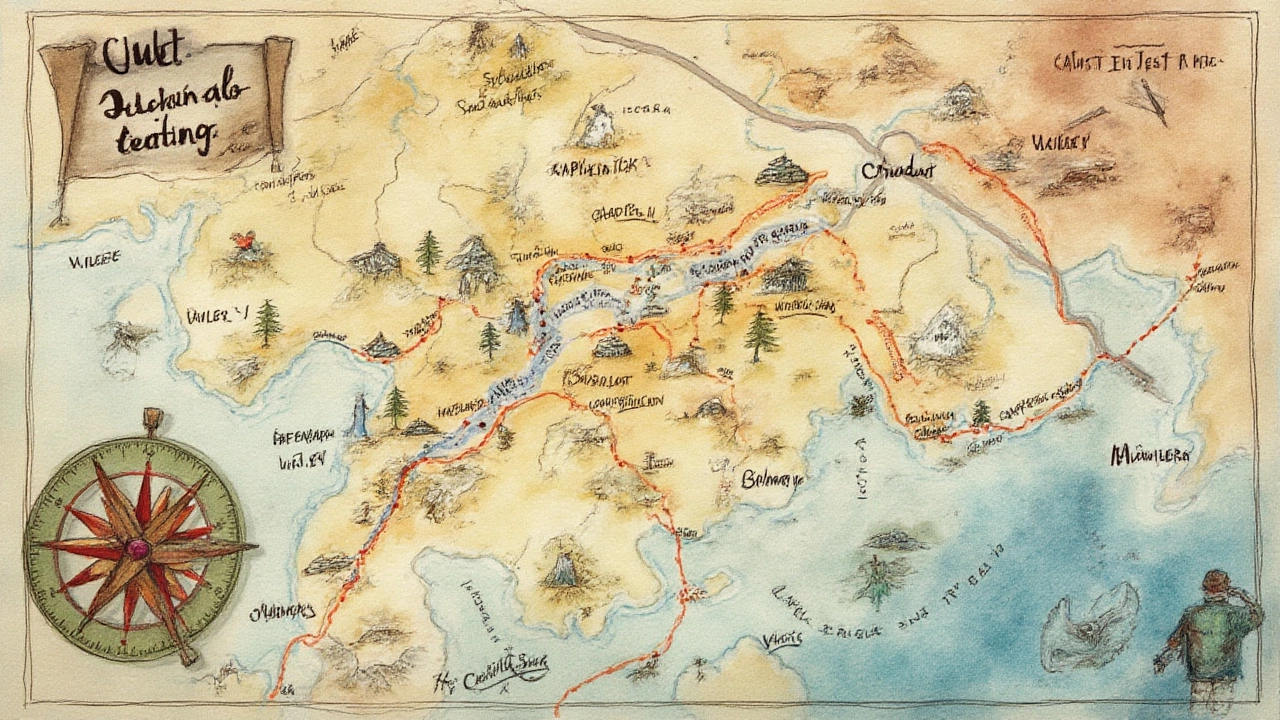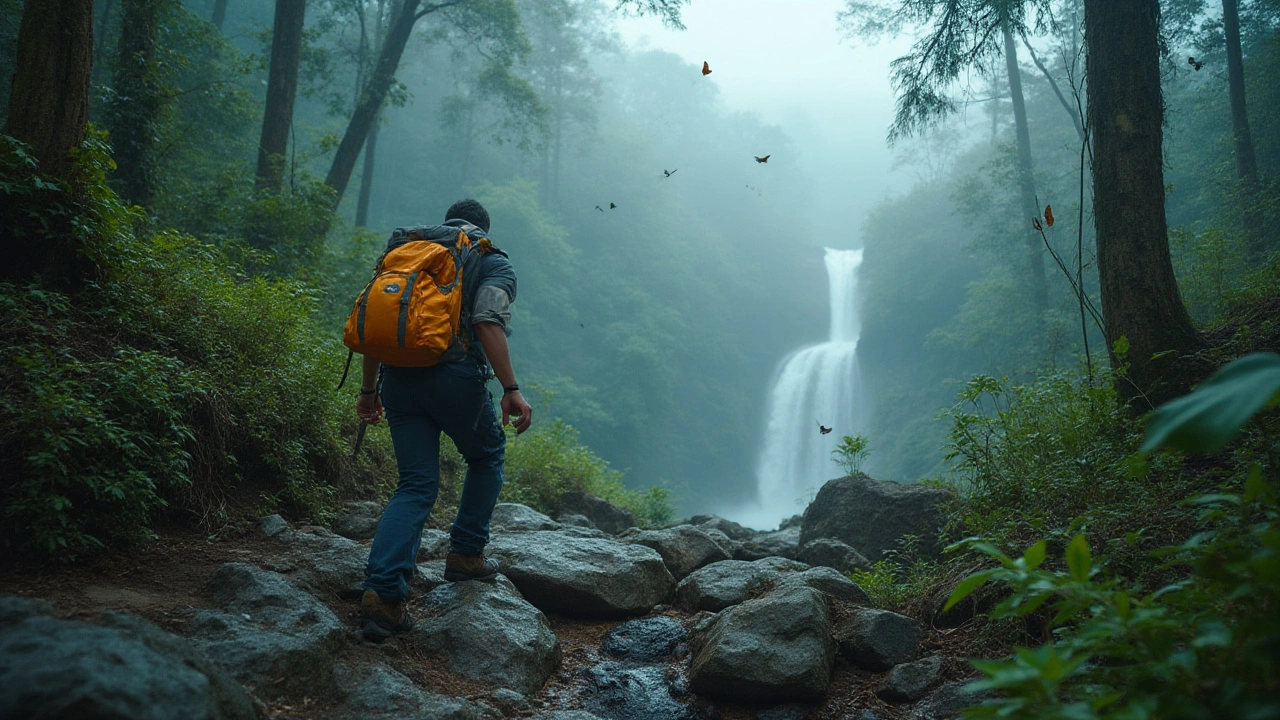Best Trekking Places in the World: Explore Top Trails and Destinations
 Jul, 22 2025
Jul, 22 2025
Ever wondered what makes a trek unforgettable? It isn’t just the altitude or the length of the trail. Sometimes, it’s the community spirit in a Himalayan teahouse, or the silent crunch of snow under your boots in the Alps, or maybe it’s the nervous excitement as you spot a blue sheep darting across Patagonian grasslands. Ask around, and every trekker swears by a different patch of earth. But when you stack experience, scenery, and good old wow-factor together, which place comes out on top? Let’s walk through the planet’s most epic trekking playgrounds, and see which one truly steals the show.
The Highs and Lows: What Makes a Trekking Place the “Best”?
People argue about the best trekking destination more fiercely than they do about favorite soccer teams. Some folks are all about views—those double-tap panoramas that blast your Instagram with likes. Others want something raw and wild: less beaten track, more heart-in-mouth adventure. You’ve got comfort seekers, happy when there are hot showers at the end of a long day, while others chase solitude, craving the sound of nothing but wind and water. So how do you compare the ancient pilgrim-trails of Peru, the lush, leech-filled jungles of Nepal, or the sharp edges of New Zealand volcanoes?
To get a fair answer, it helps to think about a few ingredients. Access is huge: a mindblowing trail you can actually get to. Wow-factor scenery, sure, but also how many cultures you pass through, what wildlife you could see, and whether you can trust the trail to keep you safe. Then there’s the toughness scale—can a fit beginner manage, or do you need lungs like a Tibetan yak? For thrills, most people look for a dose of each: challenge, beauty, and that thrill of the unknown. Season matters too; some legendary routes, like those in Patagonia or the Alps, only open their doors for a few months each year, thanks to wild weather. According to a 2024 survey on “Global Trekker Trends,” over 65% of hikers said their ‘dream trek’ had a mix of culture, wild scenery, and some touch of comfort—like friendly homestays or organized camps. Not what you’d expect from the muddy, tent-centric image of high-altitude walking, but comfort and experience now walk hand in hand. Bottom line: the best trekking spot isn’t all about being hardcore—sometimes it’s what happens when you stop to breathe (or to ask for directions in a village that looks straight out of a travel magazine).
The World’s Most Famous Trekking Destinations
Go ahead, name a legendary trek and odds are, one of these places pops out. The Everest Base Camp trek in Nepal may win the popularity contest for global trekkers, with roughly 40,000 people heading for that iconic, snowy amphitheater each year. The trail to Everest Base Camp is not just about mountain drama—it’s also about Buddhist culture, swinging suspension bridges, and yak caravans. But it’s not just Everest. The Inca Trail to Machu Picchu is another heavy-hitter. The Peruvian Andes have a way of making history feel alive, with 15th-century stone steps and cloud forest mists swirling around you the whole way. Each year, permits for the trail run out months ahead, proof that Machu Picchu’s pull is magnetic.
The Tour du Mont Blanc, circling the highest point in the Alps over 170 kilometers, covers France, Italy, and Switzerland in one fell swoop. You get glacier crossings, wildflower meadows, and pastries at the end of your day (“tartiflette” for life). Over in Africa, Mount Kilimanjaro lures around 30,000 trekkers every year, and not all of them are elite athletes. That’s the draw—it’s the highest free-standing mountain anyone with grit (and acclimatization) can actually summit, without technical climbing. Patagonia may not get numbers like Everest, but its relentless wind, spike-toothed peaks, and turquoise lakes have a cult following. Torres del Paine’s ‘W’ Trek and the Fitz Roy circuit in Argentine Patagonia are now musts for those who like their wilderness wild. Fun fact: the W trek recorded an uptick in visitors of 15% from 2022 to 2024, after a Netflix docuseries showcased its jagged beauty. And then there’s New Zealand’s Milford Track, a rain-soaked wonderland that shows off waterfalls, moss-draped forests, and sleepy fjords. It’s been called the “finest walk in the world” for over a century.
Let’s not forget remote runners-up—places like Ladakh’s Markha Valley, Canada’s West Coast Trail, the John Muir Trail in California, or Japan’s Kumano Kodo. Each of these brings a different flavor: desert drama, coastal swings, redwoods, or sacred shrines.
| Trek Name | Country | Average Duration (Days) | Annual Visitors |
|---|---|---|---|
| Everest Base Camp | Nepal | 12-14 | 40,000 |
| Inca Trail | Peru | 4-5 | 25,000 |
| Tour du Mont Blanc | France/Italy/Switzerland | 10-12 | 10,000 |
| Torres del Paine (W Trek) | Chile | 5-7 | 5,000 |
| Milford Track | New Zealand | 4-5 | 14,000 |
| Mount Kilimanjaro | Tanzania | 6-8 | 30,000 |

What Sets the Top Trekking Spots Apart?
Every leading trekking destination brings something unique to the adventure table. Nepal’s Everest Base Camp? There’s no rival for altitude drama mixed with local Sherpa culture—you get monks in red robes and mani stones etched with Tibetan prayers at 5,000 meters. In contrast, Peru’s Inca Trail winds past ancient ruins and cloud forest, landing you at Machu Picchu’s sun gate at dawn—a moment pretty much everyone rates “11/10” once they’ve had it. Ask anyone who’s circled Mont Blanc, and they’ll rave about crossing three countries in a single stride—and the switch from French “bonjour” to Swiss “grüezi” at a mountain pass makes you realize how close the world can feel when you’re on your feet.
Then, there’s the wildness. Patagonia’s Torres del Paine offers the kind of rugged, untamed feel that only comes when a place is battered by the world’s strongest winds (yes, really—the record gusts here beat anywhere else outside Antarctica). The reward for braving the gusts? Jaw-dropping views of snow-brushed pinnacles and turquoise lakes, wildlife like guanacos and condors, and light shows at dusk you’ll want to bottle up and take home. Kilimanjaro, meanwhile, holds its title as Africa’s roof, but the coolest part? You cross five very different climate zones in a single trek: think rainforest, heather moorland, alpine desert, and glacier, all before you even see sunrise from the summit.
But it’s not just about the scenery. The best treks get their status from stories: those legends you share around a campfire, the kindness of locals you meet, or the friendships built when your legs ache but the views keep you going. Want an insider tip? Trekkers who strike up conversations in teahouses or on bus rides tend to have more positive memories, according to a 2023 survey by The Adventure Travel Trade Association. Shared struggles and stories beat any fancy selfie spot. Looking for wildlife? The West Coast Trail in Canada is famous for bear tracks by the sea, while the Drakensberg Traverse in South Africa has you watching for vultures and endangered bearded vultures overhead.
What about infrastructure? Places like Nepal or the Alps spoil you with cozy refuges and village bakeries, making logistics a breeze for first-timers and pros alike. In contrast, Patagonian or Arctic adventures demand a more self-sufficient streak—pack everything you need, and prepare to embrace the elements. So the best trekking spot honestly depends on your mix: comfort, story, adrenaline, and fantasy view.
How to Choose Your Dream Trekking Destination
The world is overflowing with options, whether you want an A-list classic or a quiet adventure. Start with your “why.” Are you chasing epic views? Want to stand on top of a continent? Or maybe you want to learn about ancient cultures or test your survival skills. Decide on the kind of adventure you’re after: supported (think guided treks, hot meals, a bed), semi-supported, or wild camping. Budget matters too: the Inca Trail and Kilimanjaro can get pricey with permits and guides, while some Himalayan treks are famously affordable thanks to basic teahouses.
Season can make or break a trek. Some of the crowd favorites, like the Alps or the Milford Sound trails, are best in summer when the snow has melted and the flowers are out. In Nepal, pre-monsoon (March–May) and post-monsoon (October–November) are safest for clear skies and stable trails. If solitude is your goal, consider less-traveled routes during the shoulder months—just double check weather reports before you go. For real adventure, you have secret stunners like Peru’s Ausangate trek, Bhutan’s Snowman Trek, or the Simien Mountains in Ethiopia, where you might hike all day and meet only monkeys and birds.
Gear up right: waterproof boots are a no-brainer for rain-prone routes, while layers are lifesavers for fast-changing weather. Do a reality check on your fitness; you don’t have to be a marathon runner, but climbing stairs without losing your breath is a start. Safety is key, so learn about altitude sickness, check local trekking advisories, and make sure your travel insurance covers rescue.
- Research permits early (Inca Trail permits sell out fast, and Kilimanjaro requires a guide).
- Consider teaming up with others; many classic routes are even more memorable with good company.
- Always check park regulations and Leave No Trace principles. Treks like New Zealand’s Milford Track strictly control numbers to protect the environment.
- Factor in travel time—it sometimes takes days to reach a remote trailhead.
If you’re into culture, some trails double as spiritual journeys—like the Camino de Santiago in Spain or Japan’s Kumano Kodo, both UNESCO World Heritage pilgrim routes. For wildlife, think Canada’s West Coast Trail or Tanzania’s routes that have elephants wandering nearby.

So, Which Place Deserves the “Best” Title?
The honest answer? The best trekking place in the world depends on what you want out of the experience, but if you measure by sheer drama, cultural buzz, accessibility, and lifelong bragging rights, Everest Base Camp in Nepal takes the crown for most lovers of adventure—and it’s not just hype. Where else can you mix Buddhist monasteries, Himalayan giants, tea houses, and yaks all in one trip? But hey, trail magic isn’t reserved for Nepal. Patagonia’s Torres del Paine is rock-star status for wind lovers and those wanting wild, cinematic drama. New Zealand’s Milford Track might sweep in for those who prefer emerald-green forests and thunderous waterfalls, while Peru’s Inca Trail wins for its mix of jungle, lost cities, and real-deal mountain legends.
At the end of the day, everyone is searching for a little something different: maybe it’s the altitude of the Himalayas, the fizz of Patagonian wind, or a plate of dumplings in a mountain hut. Every classic route is famous for a reason. Pack your boots, bring your sense of wow, and let the world surprise you—it has a habit of making every trek feel like the best one yet.